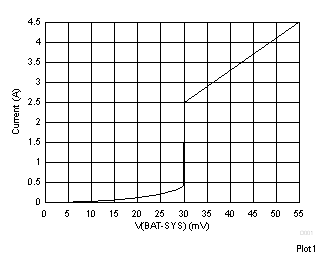SLUSDA2B July 2018 – February 2022 BQ25601D
PRODUCTION DATA
- 1 Features
- 2 Applications
- 3 Description
- 4 Revision History
- 5 Description (continued)
- 6 Device Comparison Table
- 7 Pin Configuration and Functions
- 8 Specifications
-
9 Detailed Description
- 9.1 Overview
- 9.2 Functional Block Diagram
- 9.3 Feature Description
- 9.4 Device Functional Modes
- 9.5 Protections
- 9.6 Programming
- 9.7
Register Maps
- 9.7.1 REG00 (address = 00) [reset = 00010111]
- 9.7.2 REG01 (address = 01) [reset = 00011010]
- 9.7.3 REG02 (address = 02) [reset = 10100 010]
- 9.7.4 REG03 (address = 03) [reset = 001 0001 0]
- 9.7.5 REG04 (address = 04) [reset = 01011000]
- 9.7.6 REG05 (address = 05) [reset = 10011111]
- 9.7.7 REG06 (address = 06) [reset = 01100110]
- 9.7.8 REG07 (address = 07) [reset = 01001100]
- 9.7.9 REG08 (address = 08) [reset = xxxxxxxx]
- 9.7.10 REG09 (address = 09) [reset = xxxxxxxx]
- 9.7.11 REG0A (address = 0A) [reset = xxxxxx00]
- 9.7.12 REG0B (address = 0B) [reset = 00111xxx]
- 10Layout
- 11Device and Documentation Support
Package Options
Mechanical Data (Package|Pins)
- RTW|24
Thermal pad, mechanical data (Package|Pins)
- RTW|24
Orderable Information
9.4.3 Supplement Mode
When the system voltage falls 180 mV (VBAT > VSYSMin) or 45 mV (VBAT < VSYSMin) below the battery voltage, the BATFET turns on and the BATFET gate is regulated the gate drive of BATFET so that the minimum BATFET VDS stays at 30 mV when the current is low. This prevents oscillation from entering and exiting the supplement mode.
As the discharge current increases, the BATFET gate is regulated with a higher voltage to reduce RDSON until the BATFET is in full conduction. At this point onwards, the BATFET VDS linearly increases with discharge current. Figure 9-9 shows the V-I curve of the BATFET gate regulation operation. BATFET turns off to exit supplement mode when the battery is below battery depletion threshold.
 Figure 9-9 BAFET V-I Curve
Figure 9-9 BAFET V-I Curve